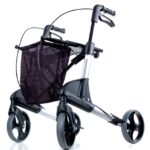Last Updated on September 3, 2020
There are many types of walkers available to assist those with limited mobility, but which one is best for your parent or the patient  you’re taking care of? You may have questions like, “What type of walker is best for elderly?,” or “What is the difference between a rollator and a walker?”
you’re taking care of? You may have questions like, “What type of walker is best for elderly?,” or “What is the difference between a rollator and a walker?”
There are varied choices when it comes to types of walkers, and you want to make sure you make the best decision for your loved one. Read on to determine your best walker option.
Different Types of Walkers for Seniors and the Elderly: Questions to Ask
There are few considerations to keep in mind as you’re making a choice. Are you looking for types of walkers with seats or a folding walker that’s easy to carry and very portable? Will you need to install some extra mobility equipment, such as handicap walker ramps or are you going to invest in portable ramps for walkers?
But, there are a few questions to ask that deal directly with your loved one’s mobility and ease of getting around:
- Can your loved one handle a walker with wheels, and can they fully control the wheels and brakes efficiently?
- What are the needed measurements? Measure your loved one’s height, weight, and lifting capacity. You may want to invest in lightweight walkers for seniors if your loved one cannot lift very much weight.
- Should the walker fold down for easy transport? If so, outdoor walkers for seniors that are easily collapsible may be a good choice.
- Does your loved one frequently get tired while walking? If so, choosing a sit-or-stand behind a rolling walker may be a good choice.
- Is your loved one relying on the walker some of the time, or relying entirely on the walker? If the walker is often used, then a rollator walker may be a good choice—but your loved one must be able to operate the brakes.
Now that you have a general idea of where to start read on to learn about the different types of walkers available so you can choose between a standard walker and other types.
What Are the Different Types of Walkers for Seniors and the Elderly?
Here are some of the most common types of walkers, along with their main features and benefits:
Basic Walker
A basic walker is generally any type of walker without wheels. It is the most common type of upright walker for seniors available and is available in both heavy duty and lightweight forms. The exclusion of wheels allows basic walkers to provide the most stability.
Basic walkers are best for use on indoor surfaces. When it comes to basic walkers, lifting capacity is a huge consideration because the person frequently lifts the unit off the ground while walking with it. You may also want to consider threshold ramps for walkers or doorway ramps for walkers so that your loved one can manage steps without lifting too much.
Wheeled Walker
Just as it sounds, a wheeled walker is a type of walker with wheels. The addition of wheels eliminates the concern for lifting capacity. Wheels help facilitate ease of movement, especially outdoors. Wheeled walkers typically have just two wheels in the front, which are fixed to go forward and backward.
The fixed nature of the wheels adds some extra stability while using the walker, compared to walkers with swiveling wheels. Wheeled walkers are best for those who will be routinely outdoors navigating through uneven terrain and is a better walker for the elderly person who is out and about.
Rollators
If you’ve ever wondered, “What do you call a walker with a seat?,” it is most often a rollator. Wheeled walkers have two wheels; rollators have four wheels. This types of walker has one wheel on each leg to provide the greatest range of motion of any walker available. Unlike wheeled walkers, many rollators come with wheels that swivel, as well as hand brakes for extra safety.
Most rollators also come standard with seats and storage baskets, making them ideal for those who are often on the go. For maximum mobility, we recommend rollators with the largest wheels.
Canes
Think of a cane as a type of walker with one leg; it still provides some stability, but certainly not as much as a full-fledged walker. Canes are a great alternative for those who don’t quite need the full stability of a walker but still need some assistance. Canes are best for those who need assistance at certain times, such as getting up from a seated position, or general help with balance while getting around.
The main differences between each are handle type, and whether or not the cane is foldable. This is often a good choice if you’re in search of a narrow walker for seniors, as it is the smallest “type” of walker.
Different Types of Walkers for Seniors and the Elderly: How Much Is a Walker for the Elderly?
Walkers can range anywhere between about $30 to $500, depending on the design and the need. Keep in mind that if you’re wondering what the types of walkers in physical therapy are used, the answer is all of them.
A good physical therapist can work with a cane, a basic walker, a two-wheeler, or a rollator. In many cases, Medicare may cover the cost of the walker, but it’s a good idea to ask your primary care physician or call Medicare to be sure.
To learn more about different types of walkers or to hear about other mobility products that can be life-changing, contact Williams Lift Co. today. We want both caregivers and their patients to live their best lives possible.
